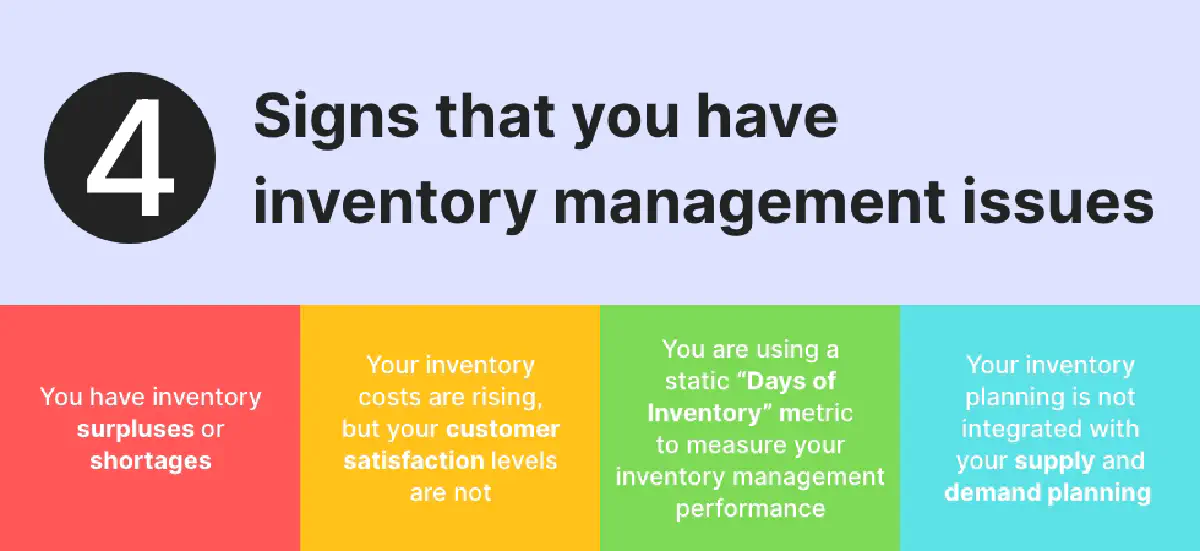Author: Zehra Melis Teksan
How do most supply chain companies – from manufacturers to retailers to suppliers to distributors – safeguard their business against the impact of demand and supply volatility? They use a secret weapon: Inventory.
What is the main purpose of inventory?
Supply chain companies employ inventory buffers as a form of protection against the unpredictability and complexity of today’s supply chain dynamics. They keep safety stock to ensure – regardless of changing market conditions, supply chain constraints, or production disruptions – that they are always able to satisfy customer demand on time, in full (OTIF).
And what is the main purpose of inventory management?
Many supply chain executives subscribe to the notion that, when it comes to inventory, more is better. But this conventional wisdom does not always hold true and often leads to poor inventory management. Indeed, even if you have an inventory surplus, that doesn’t necessarily mean that you will be able to achieve higher customer satisfaction.
The ultimate goal of inventory management is not merely to have enough inventory to meet demand, but rather to have stock of the right products in the right places at the right times – to maximize demand fulfillment while minimizing inventory costs. This is what we call inventory optimization.
Before you jump into discovering inventory optimization techniques, first you need to decide is there anything you should do differently for better inventory management. This brings us to the question “How will I know if I have an inventory problem?” In this blog, I will highlight the four signs that you have an inventory management issue, meaning that you are not managing your inventory in a smart and effective way.

1. You have inventory surpluses or shortages
The most obvious sign that your inventory levels are not being managed correctly is that you have a stock shortage or surplus. These two scenarios are the most common inventory management pitfalls that supply chain companies encounter.
Inventory shortages – simply put, not having enough inventory where and when it’s needed in order to satisfy demand – can have a devastating, detrimental impact on OTIF performance, customer satisfaction and business growth.
Conversely, inventory surpluses means that you are holding a significant amount of excess and obsolete stock in your warehouses. This can become a huge driver of skyrocketing costs for inventory production, storage, and transportation.
Having too much or not enough inventory is the most clear and common signal that you are not managing your inventory in the right way.
2. Your inventory costs are rising, but your customer satisfaction levels are not
If you are managing your inventory correctly, there should be a direct correlation between inventory costs going up and customer satisfaction going up.
If you are pumping capital into your inventory and don’t see your customer service levels rising in parallel with your inventory costs, that is an indication that your company is not optimally utilizing the inventory that you have or perhaps that you are holding stock of the wrong goods in the wrong places, and at the wrong times.
3. You are using a static “Days of Inventory” metric to measure your inventory management performance
The third telltale sign that you are not properly managing your inventory is that your planners and other key stakeholders are utilizing the wrong metrics to measure your inventory management performance.
Many firms use Days of Inventory as the main metric to gauge their inventory management performance and are perpetually looking to increase their Days of Inventory (and build up inventory buffers) so that they will be better able to handle supply chain volatility and satisfy customer demand in any circumstance.
But using Days of Inventory to manage your inventory is a strategic mistake and typically leads to a situation where you are holding excess inventory that you don’t need. This is tying up working capital that you desperately need to fund your business.
Instead of using Days of Inventory as the main as your main KPI target, you should measure your inventory management performance based on your service levels and customer satisfaction by using metrics such as OTIF performance or Fill Rate. By continuously keeping track of these KPIs, you can tell exactly how well you are utilizing your inventory to satisfy customer demand.
4. Your inventory planning is not integrated with your supply and demand planning
The final sign that you are not managing your inventory correctly is that your inventory planning and decision making are not integrated with your supply and demand planning and decision making.
If various departments across your organization are operating in silos and you conducting your inventory planning and operations in isolation, then your planners and other key stakeholders probably lack end-to-end visibility and the capability to generate data-driven, optimized inventory plans that are integrated with demand plans and forecasts and take in to account supply plans and constraints.
In order to optimize your inventory, you need to foster enhanced cross-functional, cross-level, and networkwide collaboration, alignment, and agility and Sales and Operations Planning (S&OP) excellence. This will enable you to perfectly calibrate inventory levels with demand and supply conditions, so that you can improve your inventory turns and ensure that you always have the right stock of the right goods in the right places at the right times.
Overcome your inventory challenges with ICRON
If your company is experiencing any of the abovementioned symptoms or other similar signs, chances are that you have a serious inventory management issue – which is most likely resulting in lackluster OTIF performance and surging inventory costs.
The first step to optimizing your inventory is to diagnose the roots of your inventory management problem and then find a suitable solution. Manual planning techniques and tools, like Excel, are simply not robust and sophisticated enough to deliver a solution to your inventory management woes. Ultimately, to truly achieve inventory optimization – given the speed, scope, complexity, and volatility of today’s supply chains – you will need an automated, algorithmic planning and decision-making solution, like ICRON.
With ICRON Supply Chain Planning, you will be able to:
- Generate optimal inventory plans by conducting what-if analysis to compare different scenarios,
- Rapidly revise your plans considering market conditions, your business strategy, goals, policies and constraints,
- Have full visibility and control over inventory allocations,
- Avoid both stock-outs and overstocks and find the optimal stock levels.
With ICRON you can achieve inventory optimization in order to transform inventory from a source of supply chain cost into a key driver of service excellence.
If you would like to see ICRON in action, please contact us. If you have enjoyed this blog, you can find more content that you might enjoy here.












